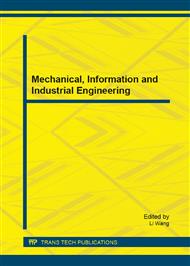p.51
p.55
p.59
p.65
p.69
p.79
p.83
p.87
p.91
Contact between Logarithmic Crowned Teeth of Spur Gear Transmission
Abstract:
Gear tooth modification such as lead crowning can reduce stress concentration at the edges of the gear teeth; therefore prolong the fatigue life of gears. A logarithmical lead profile was applied on spur gears and the surface coordinate equation of logarithmic crowned tooth for manufacturing was established. On the basis of the contact mechanics model, the deformation equation of compatibility and load equilibrium equation were solved with an iterative numerical algorithm, and the corresponding programs were developed in Matlab to calculate the distributions of contact stress and von Mises stress field inside the subsurface layer at any meshing position. The numerical results of some typical examples show that the level of stress concentration before modification changes with the engaging locations of the gear teeth, and so does the amount of logarithmic modification along the line of contact, which can completely eliminate the edge effects of tooth surface at every meshing position during the spur gear transmission process, and thus improves the fatigue resistance of gear teeth surfaces.
Info:
Periodical:
Pages:
69-78
Citation:
Online since:
March 2015
Authors:
Price:
Сopyright:
© 2015 Trans Tech Publications Ltd. All Rights Reserved
Share:
Citation:


